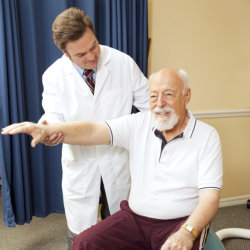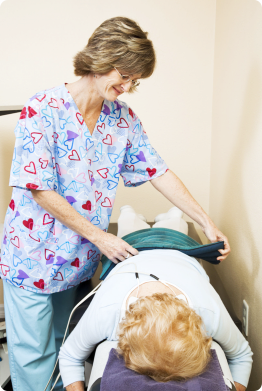 Physical therapy may be indicated prior to surgery to maximize joint motion and overall strength and endurance that will assist you in a speedier recovery post-operatively. At this time, you will be seen by a therapist as soon as it is prescribed by the physician. Treatment goals will be to minimize the adverse effects of the surgery such as pain and swelling as well as to restore normal movement, flexibility, range of motion, and function.
Physical therapy may be indicated prior to surgery to maximize joint motion and overall strength and endurance that will assist you in a speedier recovery post-operatively. At this time, you will be seen by a therapist as soon as it is prescribed by the physician. Treatment goals will be to minimize the adverse effects of the surgery such as pain and swelling as well as to restore normal movement, flexibility, range of motion, and function.
Total Joint Replacements
This is a surgery in which the worn surfaces of the joint are removed and replaced with a new artificial surface such as ceramic, metal alloy, and plastic. Rehab starts within a few hours after surgery and continue for the next 3 months or longer. You will learn how to use your new joint and return to normal activities.
Open Reduction, Internal Fixation of Fractures
Often abbreviated as ORIF, this is a method of surgically repairing a fractured bone. Generally, this involves either the use of plates and screws or an intramedullary rod to stabilize the bone.
Ligament or Tendon Reconstructions or Repair
This is a surgical procedure to correct damaged or torn tendons. Most common examples would be Rotator Cuff Repair and Anterior Cruciate Ligament reconstruction.
Low Back and Cervical Surgeries
- Discectomy. This is a procedure in which a portion of the disc that rests between each vertebra is removed.
- Foramenotomy. This procedure is used to relieve pressure on a nerve by removing a portion of the bone and other tissue that may be compressing it as it exits the spinal column.
- Laminectomy. This procedure is performed to relieve pressure on the spinal cord itself. It is most commonly used to treat conditions such as spinal stenosis and spondylolisthesis.
- Spine Fusion. This procedure is done to eliminate motion between two adjacent vertebrae. It is usually performed to treat an unstable spine (spondylolisthesis).
- Joint fusions (Arthrodesis). A surgery in which the two bones on each end of the joint are fused secondary to the joint being eroded or destroyed by trauma or severe arthritic changes. This will eliminate joint motion thus reducing pain.
Knee Surgery
- Arthroscopic knee surgery and meniscus repair
- ACL, PCL, MCL and LCL reconstruction
- Knee replacement
Shoulder Surgery
- Rotator cuff repair
- Shoulder arthroscopy
- Bankart repair
- Shoulder replacement
- Manipulation under anesthesia
Hip Surgery
- Hip fractures
- Hip replacement
Cervical and Lumbar Spine Surgery
- Laminectomy
- Spinal fusion
- Discectomy
- Vertebroplasty
Foot and Ankle Surgery
- Achilles tendon repair
- Ankle arthroscopy
- Ankle replacement
- Ankle fusion
Wrist and Elbow Surgery
- Wrist arthroscopy
- Elbow arthroscopy
- Elbow replacement
- Carpal tunnel syndrome surgery
Excel Spine and Sports Rehab PC builds and enhances each patient’s skills for living after surgery. The postoperative care that focuses on functional and manual physical therapy is our proven method of achieving that. As a result, we’re able to get patients back to living sooner, with less chance of injury. For more information about our special postoperative orthopedic physical therapy programs, please call our office.
How Can a Physical Therapist Help Before & After Total Joint Replacement Surgery?
Before Your Surgery (“Pre-op Conditioning”)
The better physical shape you are in before total joint surgery, the better your results will be (especially in the short term). Before surgery, your physical therapist will teach you exercises and show you how you will walk with assistance after your operation. Your therapist also will discuss precautions and home adaptations, such as removing loose rugs or strategically placing a chair so that you can sit instead of squatting to get something out of a low cabinet. It’s always easier to make these modifications before you have Total joint surgery.
If you smoke, quit! That may help improve your healing after surgery. If you are overweight, focus on weight loss prior to surgery. Losing excess body weight may help you recover more quickly, and help improve your function and overall results following surgery.
Immediately Following Your Surgery
With a Total Joint Replacement, you likely will stay in the hospital 2 or 3 days following your surgery. If you have other medical conditions, such as diabetes or heart disease, you might need to stay an additional few days. If you are like most patients, you will be told to put as much weight as comfortable, when standing, on the leg that had surgery. While you are in the hospital, a physical therapist will:
- show you how to practice walking with a walker or crutches
- teach you how to safely get in and out of bed or a chair
- help you continue to do the flexibility and strengthening exercises that you learned before your surgery
During this period, it’s especially important to control the swelling in your replaced joint and to help your incision heal. Your physical therapist may perform electrical stimulation, where electrodes are placed on the skin to stimulate the nerves around the joint to help reduce pain and swelling and promote healing.
As You Begin to Recover
Proper rehabilitation after a Total Joint Replacement is essential to your recovery. Your physical therapist will help you regain much of your joint’s range of motion as soon as possible. Your physical therapist can speed up (or “hasten”) your return to activity and help make your new joint just as good as the old one! Your therapist will tailor range-of-motion exercises, progressive muscle-strengthening exercises, body awareness and balance training, and activity-specific training to your specific needs.
Occasional swelling of the shoulder and arm, hip, knee joint, and lower leg can occur for up to 3 months after surgery. To relieve swelling, apply a cold pack, and elevate your extremity on a pillow when sitting or lying down.
Range-of-motion exercises. Swelling and pain can make you move your shoulder, hip, and knee less. Your physical therapist can teach you safe and effective exercises to restore the range of motion to your shoulder, hip, or knee so that you can perform your daily activities.
Strengthening exercises. The weakness of the muscles of the thigh, glutes, hip, scapula, deltoid and rotator cuff can make it difficult to move. Your physical therapist can determine which strengthening exercises are right for you with the goal of regaining full use of the new joint.
Body awareness and stability/ proprioceptive training. Specialized training exercises help your muscles “learn” to respond to changes in your world, such as uneven sidewalks or rocky ground. When you are able to put your full weight on your knee without pain, your physical therapist may add agility exercises (exercises that have you practice making quick stops and starts, turns, and changes in direction) and activities using a balance board that challenges your balance and knee control.
Your program will be based on the physical therapist’s examination of your knee, on your goals, and on your activity level and general health.
Functional training. When you can walk freely without pain, your physical therapist may begin to add activities that you were doing before your knee pain started to limit you. These might include community-based actions such as crossing a busy street or getting on and off an escalator. Your program will be based on the physical therapist’s examination of your knee, on your goals, and on your activity level and general health.
The timeline for returning to leisure or sports activities varies from person to person. Your therapist will be able to estimate yours based on your specific condition.
Activity-specific training. Depending on the requirements of your job or the type of sports you play, you might need additional rehabilitation that is tailored to your job activities (such as climbing a ladder) or sport activities (such as swinging a golf club) and the demands that they place on your joints. A physical therapist can develop a rehabilitation program that takes all of these demands into account.
Can this Injury or Condition Be Prevented?
If you have knee, hip, or shoulder pain, you may be able to delay the need for surgery by working with a physical therapist to improve the strength and flexibility of the muscles that support and move the joint. This training could even help you avoid surgery altogether. Participating in an exercise program designed by a physical therapist can be one of your best protections against injury. And staying physically active in moderately intense physical activities and controlling your weight through proper diet might help reduce the risk of osteoarthritis of the knee or hip getting worse.
To get expert advice, you may call Excel Spine and Sports Rehab PC at 469-443-0458.





